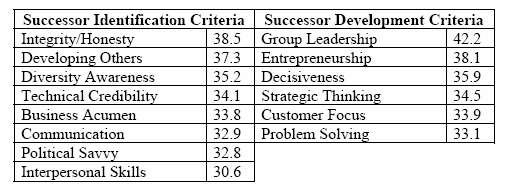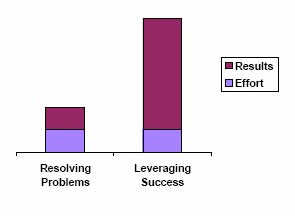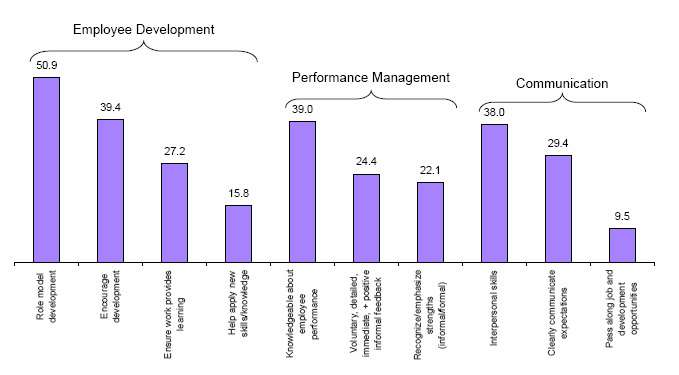What's a Manager to Do?
Jim Trinka’s study of manager-employee surveys in government and industry reveals what surely must be best-kept secrets. For example, by focusing on “developing others,” and “communication” competencies, managers can increase their overall leadership effectiveness by 50-60 percent. To drive his points home, he shows that 10 managerial activities—out of a possible 250—have the most potential for delivering high employee performance. Do yourself and other managers a favor: Read this paper and pass it on.
Applying Science to Build Leadership: Which Managerial Activities Have the Most Impact on Improving Employee Performance?
An overwhelming body of evidence exists to highlight the important and vital role of managers on employee performance and retention. However, the potential list of activities that a manager can undertake to improve employee performance is as long as the oceans are wide. Thus, questions often arise about which managerial activities have the most impact on improving employee performance and what the extent of that improvement is. Numerous experts claim that the most effective leaders use approaches that balance their focus between interpersonal skills and driving for results. These approaches seem consistent with our intuition on good leadership, yet we often have only anecdotal evidence to support such a contention.
A review of several surveys on these important topics reveals unusual similarities in findings and recommendations and suggests that an application of hard science might offer us some insight on how best to exercise and build the soft skill of leadership. Specifically, the evidence supports the establishment of a performance-management based organizational culture, although not from a command and control perspective, but one that involves a coaching environment and conscious attempts at continuous dialogue within work teams to achieve a balance between driving for results and interpersonal skills. Furthermore, managers who undertake specific activities related to this approach have a much better chance of achieving “breakthrough” employee performance improvements, leading to “breakthrough” results for the organization.
Focus on Success: What Works?
Over the past 2 years, I’ve had access to numerous surveys dealing with both employee performance and leadership effectiveness. The ones that I find particularly interesting study successful leaders and hone in on the characteristics and competencies that differentiate those leaders from the rest and focus on what is working. I find this approach much more positive than the opposite approach that probes weaknesses and what isn’t working. It’s also clear to me that we don’t identify our best leaders by an absence of shortcomings, but rather by the attributes that lead to their success and what does work. Moreover, focusing on success creates positive energy by recognizing and appreciating what is working, which seems to produce greater engagement and momentum for change. Thus, we can evaluate a long list of managerial activities and competencies to determine the much smaller number of those activities that have the most impact on improving both leadership effectiveness and employee performance, ultimately achieving dramatic increases in organizational results.
Performance Management
Most managers agree on the importance of performance management as a leader and would probably rate themselves fairly proficient in this role. In mid 2002, the Corporate Executive Board’s Learning and Development Roundtable analyzed survey responses from nearly 20,000 employees and managers on a wide range of manager-related activities involving performance management. Overall, managers received a poor report card on their performance on these activities as only 30-40 percent of employees agreed that their managers communicated performance standards and provided fair and accurate feedback to help them do their jobs better.
Immediate Feedback Works
Interestingly, most of the performance improvement activities that managers can utilize have minimal impact on individual employee performance. The results clearly show that managers have a much better chance of vastly improving employee performance by targeting their efforts on a much smaller list of activities. In fact, managers who set clear performance standards, become more knowledgeable about employee performance, and provide fair and accurate informal feedback on performance strengths can significantly improve individual performance. And when discussing weaknesses, managers who clearly focus on specific suggestions for improvement or development can improve employee performance; those who emphasize weaknesses can dramatically decrease performance. In short, managers who provide feedback that is voluntary, detailed, immediate, and positive can positively influence employee performance.1
This information shouldn’t surprise most managers as we’ve heard it all before and it seems intuitive. However, survey responses show some disparities in perceptions between employees and managers. The majority of employees believe that formal performance reviews do nothing to actually help their on-the-job performance, yet they crave voluntary and detailed informal performance feedback, especially on strengths. Interestingly, the majority of managers view formal performance reviews as an administrative requirement rather than as an influential lever to positively influence employee performance. In fact, many managers report that they specifically cite performance weaknesses to lower an employee’s rating below the highest mark rather than emphasizing strengths to raise performance ratings above minimally successful. On informal feedback, employees report that most managers provide general praise, rather than specific and detailed recognition.
Manager-Led Employee Development
Few managers would disagree on the importance of their crucial role in employee development and many spend a considerable amount of their valuable time on manager-led development activities. In early 2003, the Corporate Leadership Council’s Learning and Development Roundtable analyzed survey responses from nearly 8,500 employees and their managers on a wide range of employee development activities. The results confirm that a vast majority of managers (3 out of 4) agree that helping their employees develop is crucial to organizational success and spend about 15-20 percent of their time on employee development activities. However, the results also indicate that employees rate their managers barely above average (4.07 out of 7.0) on their effectiveness in this role and most managers do not see a significant return on their time investment.2 By examining the employee development activities of the highest rated managers, we see that some activities have a much more positive influence on improving employee performance than others. Statistical estimates show that improving a manager’s effectiveness at employee development can positively influence employee performance by as much as 25 percent.3
Target Fewer Activities
Similar to the results of the performance management survey, managers have a much better chance of vastly improving employee performance by targeting their efforts on a much smaller list of employee development activities. The top three managerial activities highlight the importance of managers ensuring that day-to-day work experiences provide learning and encourage development and that they clearly explain performance standards. Managers lament that time constraints or competing priorities limit the time they spend on employee development, but the good news is that they can undertake the activities listed above every day as a part of their normal job responsibilities to further “blur the line” between learning and work.
Effectiveness at Employee Development Increases Employee Performance
Survey responses show some fascinating disparities in perceptions between employees and managers concerning employee development. The vast majority of employees seek to learn and grow in the course of doing day-to-day work and want their managers to create a learning environment in that context. On the other hand, the majority of managers do not believe that their employees want them to emphasize development and report a lack of confidence to perform well in that role. Armed with the results of this survey and organizational support, managers can proceed with much more confidence in performing specifically targeted employee development activities and the business case is compelling. For example, managers who improve their effectiveness at employee development by only 20 percent can increase employee performance by about 5 percent. That may not sound like much, but a company with a sales force of 2,000 employees who each average $1 million in annual sales can increase company-wide annual sales by about $100 million!
Leadership Competencies
Organizations normally specify a set of leadership competencies that describe success for its managers and typically use 360-degree evaluations to assess managerial behaviors associated with these competencies. I analyzed the results of the 360-degree assessments of nearly 1,000 managers in a large government agency and found that the most successful managers (in the top 10 percent) did not receive high scores on all of the 21 designated leadership competencies. In fact, the best managers had a much smaller set of competency strengths that differentiated them from the rest.
Improving Certain Leadership Competences Can Increase Leadership Effectiveness
Similar to the results of both the performance management and employee development surveys, managers have a much better chance of vastly improving their leadership effectiveness by targeting their development efforts on a much smaller list of leadership competencies. For example, by focusing on improving the behaviors associated with the “Developing Others” and “Communication” competencies, managers can increase overall leadership effectiveness scores by 50-60 percent. The associated behaviors of these two competencies relating to employee development and performance management are: 1) creates an environment and strategy to support continuous on-the-job learning, and 2) strategically uses communication to produce enthusiasm and foster an atmosphere of open exchange and support.
Build Profound Strengths
My analysis also uncovered interesting insights into the most effective methods of improving leadership competencies. Traditional leadership development efforts focus on correcting weaknesses and, at best, achieve only small incremental improvements and do not offer an effective strategy for making “good” leaders “great,” since evaluation respondents identify the best leaders not by a lack of weaknesses, but by the possession of a few profound strengths. However, by identifying and focusing on competencies in which the manager is performing strongly, though not exceptionally, small amounts of improvement tend to dramatically increase a manager’s overall leadership effectiveness.
In addition, focusing on “competency companions” (closely related competencies that support those targeted for development) can improve a manager’s overall effectiveness even more. In fact, building a few of a manager’s existing strengths to even higher levels through developing “competency companions” can achieve behavioral improvements as much as 8 times more effective than traditional methods because, according to respondents, profound strengths in a few areas overshadow perceived weaknesses. Since this study also correlated increases in overall leadership effectiveness to employee engagement results, I discovered that correcting weaknesses only raised employee engagement scores a paltry 2-3 percent, while building a few profound strengths offered the potential of increasing employee engagement by nearly 80 percent.
Employee Engagement
Many organizations conduct periodic surveys that probe employee, and sometimes customer, attitudes and opinions relating to productivity, profitability, retention, and job/customer satisfaction. In their groundbreaking book, First Break All the Rules, Marcus Buckingham and Curt Coffman of the Gallup Organization argue that the number one reason why people thrive in an organization is their immediate supervisor and it's also the number one reason they quit. After studying the most successful companies and the factors that reveal loyal and productive employees, Buckingham and Coffman devised a set of twelve questions that most accurately measure the strength of a workplace (employee engagement). I studied the results of a Gallup Q12™ employee engagement survey with over 80,000 respondents in a large government agency and discovered that only 5 of the 12 questions differentiated the best workgroups (top 10 percent) from the rest.
Similar to the results of the previously cited surveys, managers have a much better chance of vastly improving the workplace environment for their employees by targeting efforts on a much smaller list of performance drivers. By listing the 5 key differentiating questions, we clearly see patterns of what survey respondents are telling their managers to focus on.
- Q4: In the last seven days, I have received recognition or praise for doing
good work.
- Q7: At work, my opinions seem to count.
- Q6: There is someone at work who encourages my development.
- Q12: This last year, I have had opportunities at work to learn and grow.
- Q11: In the last six months, someone at work has talked to me about my progress.
Two of the questions relate to conversations about performance, two others speak directly to the value of employee development activities, and the last implies an atmosphere of open exchange and support.
Managers and Employees Have Different Perceptions on Employee Engagement
By separating the survey responses by managers and employees, we see some disparities in perceptions concerning employee engagement. A vast majority of employees want someone at work (usually their managers) to conduct dialogues on performance, mission importance and alignment with organizational goals, emerging work trends, and career development. On the other hand, many managers do not believe that their employees want them to discuss these issues. The implications of this disparity clearly stand out when we compare the business results of the highest scoring workgroups to those with the lowest scores (remember, managerial effectiveness is the number one reason that employees thrive in an organization). In one retail chain, Buckingham and Coffman found that workgroups who scored in the top 25 percent ended the year almost 5 percent over their sales budget while those scoring in the bottom 25 percent were nearly 1 percent below budget, which amounted to a difference of $104 million. Profit/loss sheet and employee turnover comparisons pointed to an even more dramatic impact of scoring in the top 25 percent. The results of the surveys that I have cited begin to coalesce around a compelling business case for concentrating effort on managerial activities with the most impact relating to performance management, employee development, and communication.
Succession Management
Facing a continuing competitive economic environment and intense analyst scrutiny of leadership bench strength, most organizations currently place great emphasis on succession management and plan to increase investment in leadership development in the future. In 2003, Accenture surveyed over 1,000 CEOs and discovered that 5 of the top 9 corporate priorities related to workforce and leadership quality. Also in 2003, the Corporate Executive Board’s Corporate Leadership Council analyzed survey responses involving succession management from managers in 276 organizations worldwide. The survey revealed insights into the criteria (competencies) that have the greatest impact on improving potential successor identification and development. The table below depicts the results, to include the empirical impact on improving leadership quality:

Key criteria for successor identification and development include integrity/honesty and group leadership (crucial to performance management), developing others, and communication and a glance at the table suggests a needed balance between interpersonal skills and driving for results. Improving managers’ performance in these activities/competencies will undoubtedly steer the organization’s culture to support the CEO’s workforce and leadership quality initiatives and subsequently drive “breakthrough” improvements in organizational results.
Simplifying the Life of a Busy Manager
Hopefully, I’ve provided a more detailed explanation to answer this article’s tantalizing question of “What’s a Manager to Do?” Given the vast range of responsibilities and activities that managers can undertake, I think that any method of simplifying a time-oppressed manager’s life is worthwhile, especially if I can cite specific empirical evidence in support of a few key concepts. In that light, I have summarized the results of the previously cited surveys around the common themes that emerge involving employee development, performance management, and communication. The chart below depicts the most influential activities, grouped by these three common themes, in descending order of their impact on a combined index of managerial effectiveness and employee performance. Overall, activities involving employee development have the highest average impact on managerial effectiveness and employee performance at 33. 3 percent, performance management averages 28.5 percent, and communication comes in a close third at 25.7 percent.
A specific criterion of success for “great” organizations is the emphasis on specific activities that generate “breakthrough” performance improvement and not just a general emphasis on the common themes. After reviewing the impact of over 250 possible managerial activities, I recommend a short list of only ten that has the most potential for delivering high performance improvement levels, since these differentiate “great” organizations and leaders from the rest. By studying success and recognizing and appreciating what works for “great” leaders and organizations, we can determine the actions that have the most impact on performance improvement. And the best news is that busy managers can decrease emphasis on some of the activities we have done in the past that have the least impact. In other words, we can edit our “To-Do” list to ensure that all remaining activities have maximum impact. The chart below clearly shows the distinct advantage in results of applying similar levels of effort toward either resolving problems (i.e., correcting weaknesses) or leveraging success (i.e., building strengths). We can only achieve incremental improvement by emphasizing the former, while the latter offers the type of “breakthrough” results we really seek.

By focusing on just a few recommended activities, organizations can greatly improve both workforce and leadership quality, which is very high on the list of CEO top priorities and for good reason. In their excellent work, When Teams Work Best, Frank LaFasto and Carl Larson show that companies with “top tier” leadership quality (“great” leaders) outperform their competitors in revenue margins by over 500 percent, in net income by over 700 percent, and in stock price performance by over 800 percent. As we suspected, a manager’s, or maybe I should say a leader’s, role does have a significant impact on employee performance and now we can offer specific, empirically justified suggestions for improvement. It seems we can use hard science to help apply the soft skill of leadership!
Notes
Posted by GovLeaders.org with the author's kind permission.









